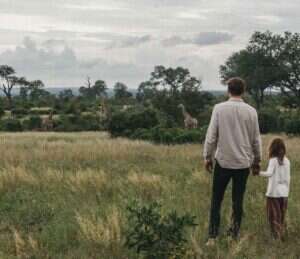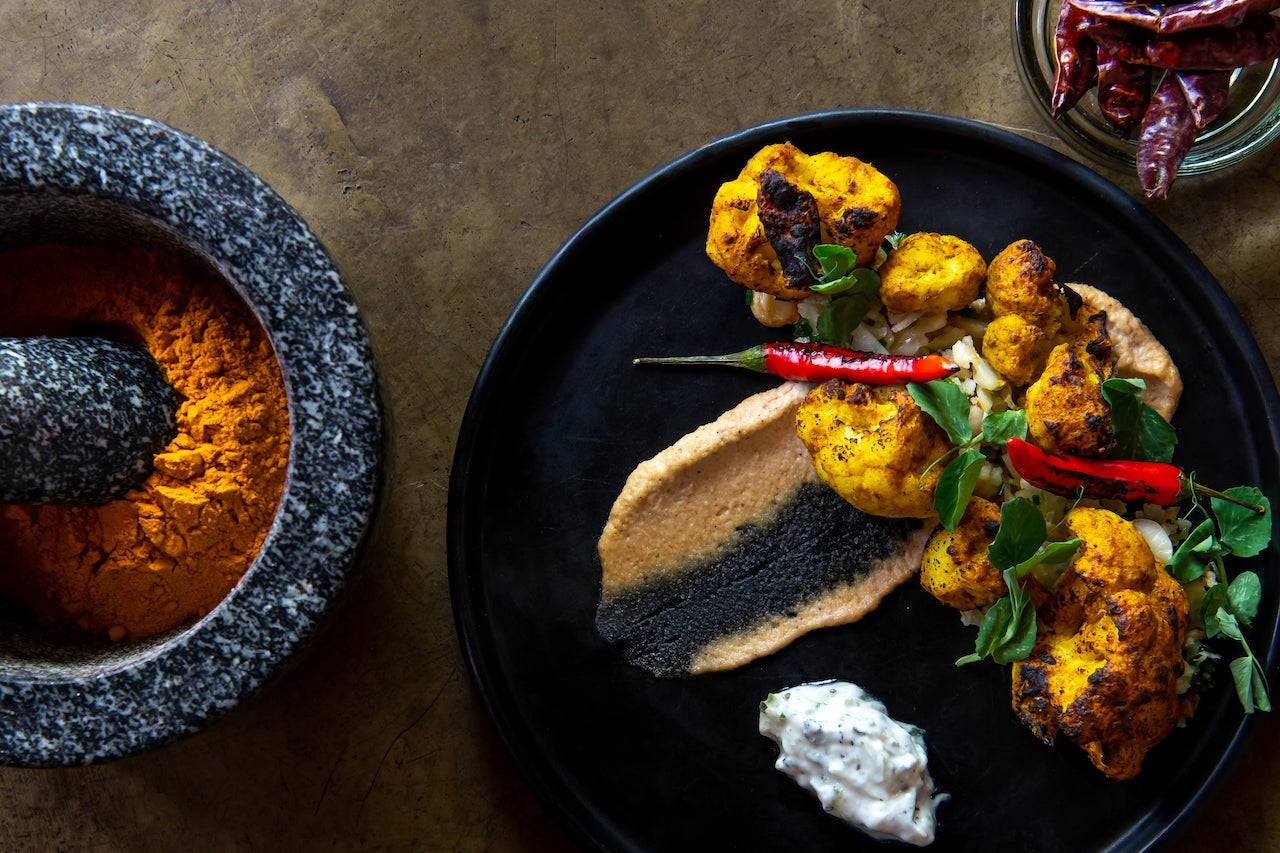
The smell of bloodied flesh rises into the warm morning air – the stench is raw, stomach-churning, offensive. A pride of lions feast on the remains of a giant hippo. It looks like a crime scene. The leader of the pride stares at me as we reverse out of the bush; amber eyes glowing, eerily transfixed on my every move. Unnerved, I slide slowly onto the middle seat as I watch her stalk over her great prize.
We set off in search of an elusive leopard and after five minutes or so, the feeling of vulnerability begins to get to me. I ask to stop for a pee break and as I stand facing a tree, surrounded by the golden grasses of the savannah, I realize just how insignificant Luke Abrahams is in the grand scheme of things. I feel like prey.
Perhaps the most beautiful thing about a safari adventure (aside from the adrenaline) is that it offers the richest gift travel can; the art of perspective. Here, hidden in the long grasses of the wilderness, you can be a human, lion, stork, snake and insect all at once. Outside in the mighty bush, however, you are all fighting for one thing; survival.
[See also: Lepogo Lodges: Luxury Safari Meets Conservation in South Africa]
 A simple game drive allows you to escape and reconnect, while offering a much-needed dose of introspection / ©Ross Couper, Singita
A simple game drive allows you to escape and reconnect, while offering a much-needed dose of introspection / ©Ross Couper, Singita Whether your ego likes it or not, the scrubland treats you as equals. Jump out of a jeep on a walking safari during a game drive and you are instantly put at the bottom of the food chain. Or simply stand under the jet-black skies getting lost in the clouds of the cosmos, and the simple insignificance of your being will hit you, fast as a shooting star. It’s a fact that might be difficult to comprehend at first, but outside of the comforts of your city, village or barn, you, are nothing but an irrelevant speck. And that, for me and many others, is the most liberating aspect of being out in the wilderness.
Terrifying stuff to think about, yes, but that’s the flair of the savannah, which Singita – the luxury ecotourism and conservation brand where I'm staying – knows all too well. Beyond the obvious draws, from finding the Big Five to those gorgeous lodges, a simple game drive allows you to escape and reconnect, while offering a much-needed dose of introspection that we seldom get in today’s fast-paced meta-universe. These are the moments to surrender yourself to the most primordial aspects of nature and it's this access to such raw vulnerability that gives a whole new meaning to the modern safari experience.
My adventure here lasts four days. It’s raining, uncharacteristically, in Singita Ebony Lodge’s stretch of the Sabi Sands Private Game Reserve, so aside from some boisterous lions, there’s nothing to be seen except for a mountain of angry clouds and the odd bull elephant ducking for cover. I’m not too worried, though. Despite the heavens throwing their worst at me, sightings of the Big Five here are among the best in Africa.
Lewis, our tracker with 18 years of experience behind him, has been tasked (by yours truly) with sniffing out an elusive cheetah, but after a morning of searching, we’ve frustratingly had no luck. While the chase is still on, Andrew, our game driver (and an avid fellow photographer) takes me and my safari companion, Saud, back to Singita's Ebony Lodge.
[See also: The Ultimate Trip to See The Great Migration in Africa]
 Singita Ebony Lodge makes you feel emersed in the landscape / ©Ross Couper, Singita
Singita Ebony Lodge makes you feel emersed in the landscape / ©Ross Couper, Singita The founding Singita Lodge, Ebony Lodge, will celebrate 30 years of being the pinnacle of South Africa’s luxury safari destinations this year. It’s a stellar piece of work. Redesigned by London-based architectural firm Cécile & Boyd, textures of nature reign supreme in this paradise of remote, wild luxury. Think three-tiered lodge chic with elevated platforms that look out onto Boulder’s River. The room dedicated to highlighting Singita’s conservation efforts to guests is the heart and soul of the place. African craftsmanship also takes center stage, with new weavings, shaded chandeliers and thatched ceilings, all the work of local artisans.
The rooms are equally impressive. Less gratuitously maximalist than some of the rival lodges dotted elsewhere on the reserve, at Singita Ebony Lodge, the accommodation is designed to make you feel both extra special and part of the landscape. River view lodges overlooking Boulder’s River give you the chance to spot game from the comfort of your bed, couch, shower, dinner table or bath. What can you see? Sitting on my deck I spy eight giraffes, a buffalo, numerous herds of elephants and the outline of a croc.
Elsewhere, adventurous couples prefer to head to the Bush Suites to be part of Mother Nature herself. Despite these suites’ much larger size, the major difference is that chance encounters with neighboring wildlife are that little bit higher – so high, in fact, that a resident leopard chose Suite 12’s sundeck as her nursing spot.
[See also: Explore Serengeti by Sky on this Hot Air Balloon Safari]
 Luxury and sustainability go hand in hand at Singita Ebony Lodge / ©Emma Jackson, Singita
Luxury and sustainability go hand in hand at Singita Ebony Lodge / ©Emma Jackson, Singita Just as much as luxury accommodation sustainable operations are firmly on the Singita agenda, and for many guests who stay here, this is the main draw. In addition to a variety of solar energy and green initiatives, environmentally aware walking safaris, local hires from nearby communities, recyclable packaging and plastic-free amenities are all part of the green package.
A quick sit down with Singita’s consultant chef Simon Orviss and head sommelier Luke Herholdt also shines a light on the sorcery behind the lodge’s eco-culinary magic. As I expect, all the food is seasonal and sourced locally and the wine is, of course, South African – as per the brand’s commitment to be more self-sufficient and sustainable. While you can order whatever you like, menus have been designed to exclude certain dishes to encourage guests to avoid adding to their carbon footprint. The result is a creative medley of dishes that are delicious and responsible at the same time. Think tasty avocado mash-ups, lean game and healthy salads that, as chef Orviss notes, “won’t leave you in a food coma”.
It's not just the food that’s making a positive impact, though. Several fascinating research projects also go on behind the scenes. Jacques, the lodge’s environmental manager, is tasked with not just ensuring the geological soil and grasses are well looked after but also works with a team of savvy science folk on all sorts of Singita-funded scientific programs. The hot ticket of the moment is conserving the reserve’s marula trees, which are a favorite of the elephants in the local area.
[See also: Safari Like a Sovereign at the Royal Thanda Club]
 Dining options are equally sustainably minded / ©Singita
Dining options are equally sustainably minded / ©Singita The team has been wrapping the trees since 2021, mapping their GPS coordinates as they go in a bid to protect them from any invading trunks and tusks in search of its delicious fruit. Jacques tells me that the “trees inform the landscape and tell us, along with the grasses, everything we need to know about the area and its ecology. It’s about protecting and conserving the natural ecosystem as much as we possibly can for us as well as the animals.”
My guide Andrew is also part of a wider group of rangers tasked with educating guests on issues from sustainable conservation to revealing the hidden treasures of the reserve. “It’s our job to gauge guests’ interests not just for their enjoyment but also to educate them about the marvels of the South African bush; how they can interact with it and help protect it from wherever they are in the world.”
Over the next few days, the dreary weather begins to clear and the bush rushes back to life. Within minutes of my first outing a herd of elephants appears, some of them so close I can hear their breath over the murmur of the jeep’s engine. Later, we watch as eagles and a secretary bird perch on lightning-struck trees, as impala, buffalo and zebra flourish side-by-side. Rhinos dance in mud baths to mark their territory, lions feast under a baking sun and leopards rise from the grasses to perch by the trees until dusk falls.
And the cheetah? Lewis finds it at last, basking in the sun, overlooking his kingdom. For me, the serenity of this intimate moment is broken only by one bittersweet thought: I’m not sure it can get better than this.
[See also: Experiencing a Slower South African Safari at Bushmans Kloof]

 German (DE)
German (DE)  English (US)
English (US)  Spanish (ES)
Spanish (ES)  French (FR)
French (FR)  Italian (IT)
Italian (IT)  Macedonian (MK)
Macedonian (MK) 







Comments